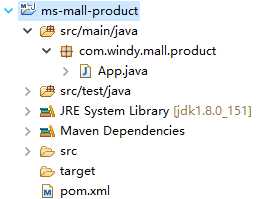1. 创建一个Maven项目,
目录结构:

pom.xml文件内容如下:
<project xmlns="http://maven.apache.org/POM/4.0.0" xmlns:xsi="http://www.w3.org/2001/XMLSchema-instance" xsi:schemaLocation="http://maven.apache.org/POM/4.0.0 http://maven.apache.org/xsd/maven-4.0.0.xsd"> <modelVersion>4.0.0</modelVersion> <groupId>com.windy.mall.product</groupId> <artifactId>ms-mall</artifactId> <version>1.0.0-SNAPSHOT</version> <packaging>jar</packaging> <parent> <groupId>org.springframework.boot</groupId> <artifactId>spring-boot-starter-parent</artifactId> <version>1.4.0.RELEASE</version> </parent> <name>ms-mall</name> <url>http://maven.apache.org</url> <properties> <project.build.sourceEncoding>UTF-8</project.build.sourceEncoding> <maven.compiler.source>1.8</maven.compiler.source> <maven.compiler.target>1.8</maven.compiler.target> </properties> <dependencies> <dependency> <groupId>org.mybatis</groupId> <artifactId>mybatis</artifactId> <version>3.4.1</version> </dependency> <dependency> <groupId>mysql</groupId> <artifactId>mysql-connector-java</artifactId> </dependency> <dependency> <groupId>org.springframework.boot</groupId> <artifactId>spring-boot-starter-jdbc</artifactId> </dependency> <dependency> <groupId>org.springframework.boot</groupId> <artifactId>spring-boot-starter-web</artifactId> </dependency> <dependency> <groupId>org.mybatis.spring.boot</groupId> <artifactId>mybatis-spring-boot-starter</artifactId> <version>1.1.1</version> </dependency> </dependencies> </project>
2. 创建数据库,sql如下:
create database db_products default charset utf8; create table products (pid int not null primary key auto_increment, pname varchar(200), type varchar(50), price double, createTime timestamp)
3. 创建resouces folder: src/main/resources,并创建application.properties文件
spring.datasource.url=jdbc:mysql:///db_products?useSSL=false spring.datasource.username=*** spring.datasource.password=***
4. 创建实体类package: bean,并创建实体类Product.java
package com.windy.mall.product.bean;
import java.sql.Timestamp;
public class Product {
private Integer pid;
private String pname;
private String type;
private Double price;
private Timestamp createTime;
public Integer getPid() {
return pid;
}
public void setPid(Integer pid) {
this.pid = pid;
}
public String getPname() {
return pname;
}
public void setPname(String pname) {
this.pname = pname;
}
public String getType() {
return type;
}
public void setType(String type) {
this.type = type;
}
public Double getPrice() {
return price;
}
public void setPrice(Double price) {
this.price = price;
}
public Timestamp getCreateTime() {
return createTime;
}
public void setCreateTime(Timestamp createTime) {
this.createTime = createTime;
}
public String toString() {
return "Product [pid=" + pid + ", pname=" + pname + ", type=" + type + ", price=" + price + ", createTime="
+ createTime + "]";
}
}
5. 创建Mapper package:mapper,并创建一个Mapper接口:ProductMapper(整合Mybatis,基于注解的形式)
Mybatis会帮助我们自动创建实现类, 我们只需要声明接口即可.
问题: 如何使用Mybatis的逆向工程,自动生成实体类,并且Mapper接口都是以注解的形式存在,而并非XML形式?
package com.windy.mall.product.mapper;
import java.util.List;
import org.apache.ibatis.annotations.Delete;
import org.apache.ibatis.annotations.Insert;
import org.apache.ibatis.annotations.Mapper;
import org.apache.ibatis.annotations.Select;
import org.apache.ibatis.annotations.Update;
import com.windy.mall.product.bean.Product;
@Mapper
public interface ProductMapper {
@Insert("insert into products(pname,type,price)values(#{pname},#{type},#{price})")
public Integer add(Product product);
@Delete("delete from products where pid=#{arg1}")
public Integer deleteById(Integer id);
@Update("update products set pname=#{pname},type=#{type},price=#{price} where pid=#{id} ")
public Integer update(Integer id);
@Select("select * from products where pid=#{arg1}")
public Product getById(Integer id);
@Select("select * from products order by pid desc")
public List<Product> queryByLists();
}
6. 针对Mapper的单元测试(待补充)
7. 创建一个响应类Response,把所有返回结果信息,封装在这个类中.
package com.windy.mall.product.utils;
public class Response {
/*
* code: 标志状态码
* 200:表示成功
* 404: 表示资源不存在
* 500:表示失败
*/
private String code;
private String msg;
private Object data;
public Response() {
super();
}
public Response(String code, String msg) {
super();
this.code = code;
this.msg = msg;
}
public Response(String code, String msg, Object data) {
super();
this.code = code;
this.msg = msg;
this.data = data;
}
public String getCode() {
return code;
}
public void setCode(String code) {
this.code = code;
}
public String getMsg() {
return msg;
}
public void setMsg(String msg) {
this.msg = msg;
}
public Object getData() {
return data;
}
public void setData(Object data) {
this.data = data;
}
}
8. 创建Controller类(由于只是简单的Demo,所以没有实现Service层)
package com.windy.mall.product.controller;
import org.springframework.beans.factory.annotation.Autowired;
import org.springframework.web.bind.annotation.DeleteMapping;
import org.springframework.web.bind.annotation.GetMapping;
import org.springframework.web.bind.annotation.PathVariable;
import org.springframework.web.bind.annotation.PostMapping;
import org.springframework.web.bind.annotation.PutMapping;
import org.springframework.web.bind.annotation.RestController;
import com.windy.mall.product.bean.Product;
import com.windy.mall.product.mapper.ProductMapper;
import com.windy.mall.product.utils.Response;
@RestController
public class ProductController {
@Autowired
private ProductMapper productMapper;
@PostMapping("/ms/product/add")
public Object add(Product product){
Integer res = productMapper.add(product);
if(res == null){
return new Response("200", "Success!");
}
return new Response("500","Fail!");
}
@PutMapping("/ms/product/update")
public Object update(Product product ){
return new Response("200", "Success!", productMapper.update(product));
}
@GetMapping("/ms/product/{id}")
public Object get(@PathVariable("id") Integer id ){
return new Response("200", "Success!", productMapper.getById(id));
}
@GetMapping("/ms/products")
public Object list(){
return new Response("200","Success!", productMapper.queryByLists());
}
@DeleteMapping("/ms/product/{id}")
public Object delete(@PathVariable("id") Integer id ){
Integer res = productMapper.deleteById(id);
return res==1? new Response("200","Success!") : new Response("500", "Fail!");
}
}
